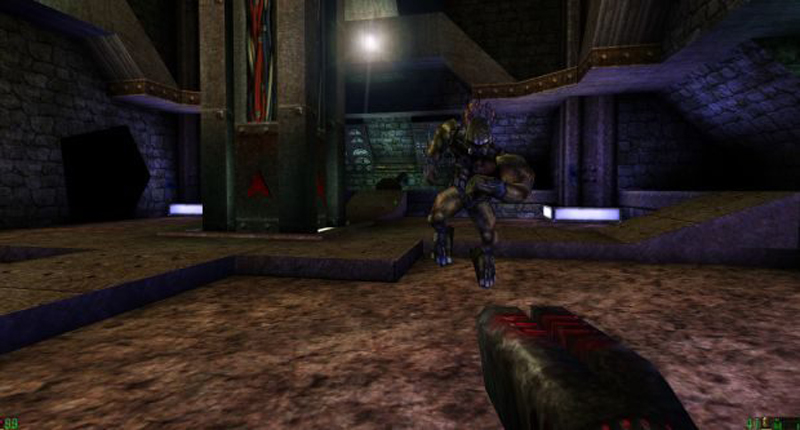The legendary Unreal shooter turned 20 years old. In honor of the anniversary, developers told how the game was created.
The history of the project began in 1994. The author of the original concept was James Schmalz from Digital Extremes, which he still heads. Among those to whom Schmaltz showed his achievements was Tim Sweeney, the head of Epic MegaGames, the current Epic Games.
Schmaltz made level plans using paper and pen, Sweeney suggested creating a convenient engine for their design, which is now known as the Unreal Engine.
Two development teams have merged. They didn’t have the right experience to develop such ambitious projects, but they had inspiration.
ALIEN RAT – THIEVES
For artist Mike Leathem, working on Unreal was the first full-time project. Moreover, Mike, who had never even seen graphics tablets before, began working with modern computer graphics for the first time.
“It was all fascinating and scary at the same time. On the one hand – the impostor syndrome, on the other – so many new opportunities. I didn’t understand what I was doing at all, and I was learning something new every day,” says Mike.
Things went awry from time to time. This is exactly what happened when the fauna of the alien world was replenished with tiny creatures resembling rats and running under the feet of the player:

“I don’t remember who suggested making background animals in the game, so to speak,” says Mike. – But I remember doing a sketch for a cow of the Nali race. And I was very disappointed to see these creatures in the game: there were only enough polygons for a couple of legs and a tiny tail. And they had to be animals comparable in scale to stegosaurs.”
In general, the project clearly lacked a well-thought-out plan, but the creators could include everything they wanted there.
LIVE SOUND
The developers wanted the game world to look alive, real. And not only looked, but also sounded. The developers suggested composer Alexander Brandon and his colleagues to make the musical content interactive.
It was an unusual concept at that time, which he had not met before: instead of one looped track per level, the game changed the soundtrack depending on the player’s actions.
“We talk about things that now seem familiar, but then they were not familiar. What if the player walks back and forth near a point that serves as a trigger for a new track? We can’t let the music change all the time. What to do: use a timer? Or is it the distance? It was a whole new way of creating a soundtrack.”
Brandon is very pleased with the soundtrack and still regrets that it could not be released as a separate release – the publisher opposed this, and agreed only to a limited release along with other merchandising. The composer is sure that a CD with music from the game would sell great.
The recording of the music took place in the same atmosphere of freedom and creativity. The game’s artist Artur Bialas recalls that once for the soundtrack it was necessary to record a live session on Cuban conga drums. And another time Tim Sweeney played “some very cool riffs on the saxophone.”
COMPETITION FOR THE BEST LEVEL
Bialas also recalls how the levels of the game were developed. A friendly competition unfolded between the level designers: everyone got a location and had to outdo the others. Therefore, designers constantly asked artists to draw custom textures specifically for their level.
In the final version of the game, the introductory level screensavers contained titles with the name of a specific designer.

“Shortly after the game was released, the team working on the project dispersed. Some of them we didn’t meet for many years afterwards. I miss that camaraderie and the feeling that you are working together on something truly innovative,” Arthur admits.
ALL-IN
Of course, the developers have a lot of fun and pleasant memories left. But everything was not so rosy at all.
Lead designer James Schmaltz described the process of working on the title in four words: “brutal”, “terrible”, “fascinating” and “amazing”. The more effort the developers gave to the project, the more often conflicts arose in the team.
“In the last year of development, we had working weeks of 70-80 hours. But the team understood that we were doing something special,” recalls Schmaltz. “We were in our 20s, we could make sacrifices and were ready for it. But we really burned out emotionally.”
For Schmaltz, it was all-in: he personally invested $ 1 million dollars in the project and could not allow failure.
And there was no failure. Although the developers broke all the deadlines and made a lot of extra assets that were not included in the final version, the game was ready and became one of the most significant developments in the history of shooters.

You can still play Unreal now – the Unreal Gold version is available on Steam and on GOG.
Also on the topic:
- A new program for financing indie projects on Unreal Engine 4 has been opened
- The Unreal Tournament designer has made his Game Design Books Free
A source: Rockpapershotgun
